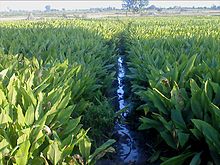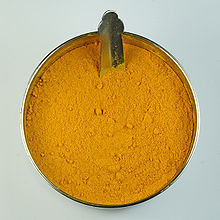
Turmeric
Background to the schools Wikipedia
SOS Children have produced a selection of wikipedia articles for schools since 2005. Click here for more information on SOS Children.
| Indian Turmeric | |
|---|---|
 |
|
| Curcuma longa | |
| Scientific classification | |
| Kingdom: | Plantae |
| (unranked): | Angiosperms |
| (unranked): | Monocots |
| (unranked): | Commelinids |
| Order: | Zingiberales |
| Family: | Zingiberaceae |
| Genus: | Curcuma |
| Species: | C. longa |
| Binomial name | |
| Curcuma longa Linnaeus |
|
Turmeric (Curcuma longa) English pronunciation: /ˈtɝːmərɪk/ is a rhizomatous herbaceous perennial plant of the ginger family, Zingiberaceae. It is native to tropical South Asia and needs temperatures between 20°C and 30°C (68°F and 86°F) and a considerable amount of annual rainfall to thrive. Plants are gathered annually for their rhizomes, and propagated from some of those rhizomes in the following season. In Vietnam, turmeric is called "nghệ", "củ nghệ".
When not used fresh, the rhizomes are boiled for several hours and then dried in hot ovens, after which they are ground into a deep orange-yellow powder commonly used as a spice in curries and other South Asian and Middle Eastern cuisine, for dyeing, and to impart colour to mustard condiments. Its active ingredient is curcumin and it has a distinctly earthy, slightly bitter, slightly hot peppery flavor and a mustardy smell.
Production and etymology
India and Pakistan are significant producers of turmeric which has regional names based on language and country. The name appears to derive from the Latin, terra merita (merited earth) or turmeryte, possibly related to saffron. As turmeric is a natural botanical compound, it is not patentable.
History
Turmeric has been used in India for thousands of years and is a major part of Ayurvedic medicine. It was first used as a dye and then later for its possible medicinal properties.
Uses
Culinary uses
Turmeric grows wild in the forests of South and Southeast Asia. It is one of the key ingredients in many Asian dishes. Indian traditional medicine, called Ayurveda, has recommended turmeric in food for its potential medicinal value, an active research topic. Its use as a coloring agent is not of primary value in South Asian cuisine.
In Vietnam, turmeric powder is used to color and enhance the flavours of certain dishes, such as bánh xèo, bánh khọt and mì quảng. The powder is also used in many other Vietnamese stir fried and soup dishes.
In Indonesia, the turmeric leaves are used for Minangese or Padangese curry base of Sumatra, such as rendang, sate padang and many other varieties.
Although most usage of turmeric is in the form of rhizome powder, in some regions (especially in Maharashtra, Goa, Konkan and Kanara), leaves of turmeric are used to wrap and cook food. This usually takes place in areas where turmeric is grown locally, since the leaves used are freshly picked. This imparts a distinct flavor.
In recipes outside South Asia, turmeric is sometimes used as an agent to impart a rich, custard-like yellow color. It is used in canned beverages and baked products, dairy products, ice cream, yogurt, yellow cakes, orange juice, biscuits, popcorn colour, sweets, cake icings, cereals, sauces, gelatins, etc. It is a significant ingredient in most commercial curry powders. Turmeric is mostly used in savory dishes, as well as some sweet dishes, such as the cake Sfouf.
Although typically used in its dried, powdered form, turmeric is also used fresh, like ginger. It has numerous uses in Far Eastern recipes, such as pickle made from fresh turmeric which contains large chunks of soft turmeric.
Turmeric is widely used as a spice in South Asian and Middle Eastern cooking. Many Persian dishes use turmeric as a starter ingredient. Almost all Iranian fried dishes typically consist of oil, onions and turmeric followed by any other ingredients that are to be included. In Nepal, turmeric is widely grown and extensively used in many vegetable and meat dishes for its colour, as well as for its potential value in traditional medicine. In South Africa, turmeric is used to give boiled white rice a golden colour.
In India, turmeric plant leaf is used to prepare special sweet dishes, patoleo, by layering rice flour and coconut- jaggery mixture on the leaf, and then closing and steaming it in a special copper steamer (goa).
In medieval Europe, turmeric became known as Indian saffron since it was widely used as an alternative to the far more expensive saffron spice.
Preliminary medical research
Phytochemicals found in turmeric have been investigated in preliminary research for their potential effects on diseases, such as cancer, Alzheimer's disease, arthritis, diabetes and other clinical disorders. As an example of such basic research, turmeric reduced the severity of pancreatitis-associated lung injury in mice.
According to one report, research activity into curcumin and turmeric is increasing. The U.S. National Institutes of Health currently has registered 71 clinical trials completed or underway to study use of dietary curcumin for a variety of clinical disorders (dated September 2012).
Some research shows compounds in turmeric to have anti-fungal and anti-bacterial properties; however, curcumin is not one of them.
In another preliminary research example, curcumin is being studied for whether it alters the response to chemotherapy in patients with advanced bowel cancer, as found in a laboratory study.
Dye
Turmeric makes a poor fabric dye, as it is not very light fast. However, turmeric is commonly used in Indian and Bangladeshi clothing, such as saris and Buddhist monks' robes.Turmeric (coded as E100 when used as a food additive, indicating how it is used as a food coloring since it normally gives food slightly yellow colour) is used to protect food products from sunlight. The oleoresin is used for oil-containing products. The curcumin/ polysorbate solution or curcumin powder dissolved in alcohol is used for water-containing products. Over-coloring, such as in pickles, relishes, and mustard, is sometimes used to compensate for fading.
In combination with annatto (E160b), turmeric has been used to colour cheeses, yogurt, dry mixes, salad dressings, winter butter and margarine. Turmeric is also used to give a yellow colour to some prepared mustards, canned chicken broths and other foods (often as a much cheaper replacement for saffron).
Hair removal
Turmeric has also been used in India as a method for hair removal and skin treatment. It is usually made into a paste with yogurt or milk, applied to the desired area and allowed to dry. After it dries it is rubbed off taking some hair with it. This process is repeated many times and ultimately prevents future hair from growing in that area.
Ceremonial uses
Turmeric is considered highly auspicious in India and has been used extensively in various Indian ceremonies for millennia. Even today it is used in every part of India during wedding ceremonies and religious ceremonies.
It is used in Pujas to make a form of Lord Ganesha. Ganesha, the remover of obstacles, is invoked at the beginning of almost any ceremony and a form of Ganesha for this purpose is made by mixing turmeric with water and forming it into a cone-like shape.
Gaye holud (literally "yellow on the body") is a ceremony observed mostly in the region of Bengal (comprising Bangladesh and Indian West Bengal). The gaye holud takes place one or two days prior to the religious and legal Bengali wedding ceremonies. The turmeric paste is applied by friends to the bodies of the couple. This is said to soften the skin, but also colors them with the distinctive yellow hue that gives its name to this ceremony. It may be a joint event for the bride and groom's families, or it may consist of separate events for the bride's family and the groom's family.
During the south Indian festival Pongal, a whole turmeric plant with fresh rhizomes is offered as a thanksgiving offering to Surya, the Sun god. Also, the fresh plant sometimes is tied around the sacred Pongal pot in which an offering of pongal is prepared.
In southern India, as a part of the marriage ritual, dried turmeric tuber tied with string is used to replace the Mangalsutra temporarily or permanently. The Hindu Marriage act recognizes this custom. Thali necklace is the equivalent of marriage rings of west. In western and coastal India, during weddings of the Marathi and Konkani people turmeric tubers are tied with strings by the couple to their wrists during a ceremony called Kankanabandhana.
Modern Neopagans list it with the quality of fire, and it is used for power and purification rites.
Friedrich Ratzel in The History of Mankind reported in 1896 that in Micronesia the preparation of turmeric powder for embellishment of body, clothing and utensils had a highly ceremonial character. He quotes an example of the roots being ground by four to six women in special public buildings and then allowed to stand in water. The following morning, three young coconuts and three old soma nuts are offered by a priestess with prayer, after which the dye which has settled down in the water is collected, baked into cakes in coconut molds, wrapped in banana leaves, and hung up in the huts till required for use.
Composition
Turmeric contains up to 5% essential oils and up to 5% curcumin, a polyphenol. Curcumin is the active substance of turmeric and curcumin is known as C.I. 75300, or Natural Yellow 3. The systematic chemical name is (1E,6E)-1,7-bis(4-hydroxy-3-methoxyphenyl)-1,6-heptadiene-3,5-dione.
It can exist at least in two tautomeric forms, keto and enol. The keto form is preferred in solid phase and the enol form in solution. Curcumin is a pH indicator. In acidic solutions (pH <7.4) it turns yellow, whereas in basic (pH > 8.6) solutions it turns bright red.






